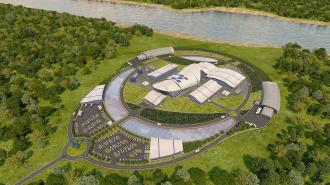The US Nuclear Regulatory Commission (NRC) has certified the design of a small modular reactor for the first time — potentially opening the door to cheaper, safer nuclear power plants.
Nuclear power: When atoms are split, they release a tremendous amount of energy in the form of heat. Nuclear power plants trigger that process in reactors, and then use the heat to boil water, creating steam that spins electricity-generating turbines.
Nuclear power plants don’t generate greenhouse gas emissions, making them a cleaner source of electricity than coal or natural gas, and they’re more consistent than solar or wind farms while also taking up less space.
The challenge: Despite these benefits, nuclear power is on the decline in the US, with old plants shutting down faster than new ones are being built.
Small modular reactors may be a way to reinvigorate the nuclear power industry.
Cost is a major reason for this decline. Owners of aging plants are opting to shutter them rather than pay for costly repairs, and few want to commit to building brand new reactors with the designs we have, as that can cost upwards of $10 billion and take 7 years.
Add in the falling cost of renewables and a public that can be wary of nuclear power due to safety concerns, and the idea of getting into the nuclear business seems even less appealing.
What’s new? Dozens of companies see small modular reactors as a way to reinvigorate the industry.
Unlike reactors in nuclear plants today, which are all unique designs built on site, these reactors would be standardized and built on an assembly line. The small reactors could then be shipped to a site, cutting the cost and time needed to establish a new nuclear power plant.
“Small modular reactors are no longer an abstract concept.”
Kathryn Huff
Now that the NRC has certified its first small modular reactor design — developed by Oregon-based energy company NuScale — we’ll finally get a chance to see if they live up to their promise in the US.
“SMRs are no longer an abstract concept,” said Assistant Secretary for Nuclear Energy Kathryn Huff. “They are real, and they are ready for deployment thanks to the hard work of NuScale, the university community, our national labs, industry partners, and the NRC.”
The tech: At just 76 feet tall, NuScale’s reactor is about one-third the size of other certified reactor designs. It can generate 50 megawatts of electricity — that’s only about 5% as much as a traditional reactor, but a single plant could host up to 12 reactors, according to NuScale.
NuScale’s small modular reactor also has a passive cooling system, designed to prevent the reactor from melting down even if the cooling system loses power, which could help alleviate safety concerns.
Looking ahead: Now that the NRC has certified the design of NuScale’s small modular reactor, anyone interested in building a new plant powered by the tech can apply for a license to use it.
It might not be long before we see these reactors up and running, either — NuScale says it has signed 19 agreements with groups in the US and internationally to deploy the reactors.
We’d love to hear from you! If you have a comment about this article or if you have a tip for a future Freethink story, please email us at [email protected].






